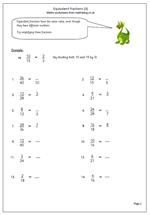 Equivalent fractions are fractions which look different but have the same value. The easiest example of equivalent fractions is a half and two quarters. If I have half of a fruit cake that is the same as having two quarters of the same cake. (As long as I pick up all the crumbs from cutting it!)
Equivalent fractions are fractions which look different but have the same value. The easiest example of equivalent fractions is a half and two quarters. If I have half of a fruit cake that is the same as having two quarters of the same cake. (As long as I pick up all the crumbs from cutting it!)
Not all equivalent fractions are that easy to work out, but as a rule it can be said that:
If we multiply the top and bottom numbers in a fraction by the same value we will get an equivalent fraction.
The same can be said of division:
If we divide the top and bottom numbers of a fraction by the same value we will get an equivalent fraction.
Dividing is really useful as it ‘simplifies’ the fraction, often making it easier to read or to picture. For example 10/100 is equivalent to 1/10 as both top and bottom have been divided by 10.
Now, the fraction will only get simpler if we can successfully divide both top and bottom numbers without leaving a remainder! This is the key, and, as so often, a good knowledge of tables helps here.
This worksheet looks at simplifying fractions. As shown above, this is done by dividing the top and bottom of the fraction by the same number. This division process might need to be done more than once. For example: 8/12 can be simplified to 4/6. This in turn can be simplified to 2/3.
this is very helpful and useful for everyone